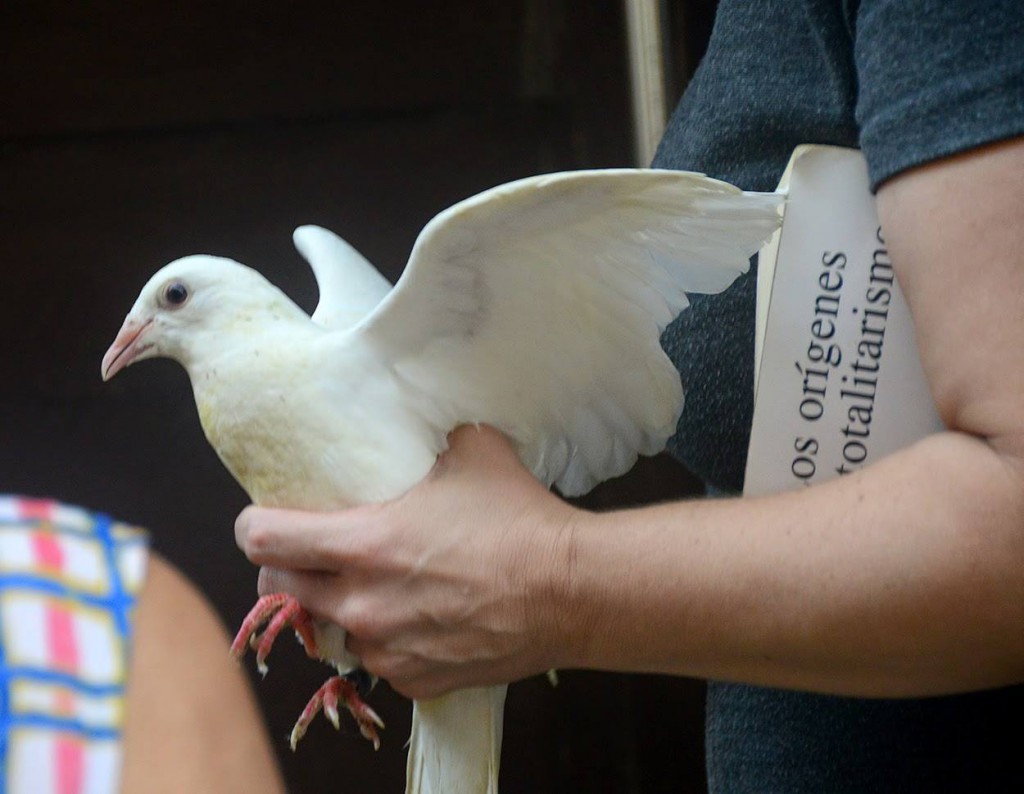
Tania Bruguera releases a dove just prior to her arrest, May 2015. Photo: Kate Flint, Yo También Exijo
“The gap between American froth and Cuban reality at this year’s [Havana] Biennial warns that the pace of change will be stubborn,” writes Kevin Lees for the Washington Post on political efforts to improve relations between the two countries. Citing recent detentions of artists like Tania Bruguera and Danilo Maldonado Machado (aka El Sexto)—a political cartoonist who has been incarcerated since December—he notes that while a majority of Cubans look favorably on closer ties with the US, around three quarters remain fearful of expressing themselves for fear of retribution from authorities. Cuban curator and co-founder of the Bienal de la Habana Gerardo Mosquera writes that “the Cuba-USA détente will not mean progress in human rights on the island, at least not in the short term.” In his eyewitness report on the arrest of Bruguera in late May following her 100-hour reading of Hannah Arendt’s The Origins of Totalitarianism, he writes, “I think that I had the privilege of witnessing a unique case in art history: a street performance that was completed in response to its very repression.”
- So beloved on the Internet that it’s been replicated on everything from a car to fingernail polish to sweatshirts and smartphone cases, the ubiquitous 1988 Solo cup design known as “Jazz” is a bona fide meme. But until now, its creator has gone unnamed. Now, thanks to intrepid reporter Thomas Gounley, the design is credited to one Gina Ekiss, an in-house artist at Sweetheart Cup Company who made the iconic teal-and-purple design in 1988.
- “The positive thing is that it highlights the creative force of an inanimate object,” says Anish Kapoor after hearing that his new installation at Versailles—which he noted resembles “the vagina of the queen coming into power”—has been vandalized. Writing in the Guardian, he ponders how he should respond: “Should the paint that has been thrown all over the sculpture be removed? Or should it remain and be part of the work? Does the political violence of the vandalism make Dirty Corner “dirtier”? Does this dirty political act reflect the dirty politics of exclusion, marginalisation, elitism, racism, Islamophobia? The question I ask of myself is: can I, the artist, transform this crass act of political vandalism and violence into a creative act? Would this not be the best revenge?”
- Mark Bradford engages with what he calls “social abstraction”—abstract art “with a social or political context clinging to the edges.” Calvin Tomkins profiles Bradford in advance of Scorched Earth at the Hammer Museum, the LA artist’s first show in his hometown, which looks at topics from AIDS to race.
- “It reminds people they do count. They are being acknowledged.” Before he leaves Chicago for a teaching job in Florida, conceptual artist Jason Lazarus wanted a parting gift: Saturday he arranged a group photo of the local arts community—or 600 members of it, at least—on the front steps of MCA Chicago.
- Austrian artist Erwin Wurm’s sculpture of a truck backed up a wall has been ticketed for illegal parking. Installed on an exterior wall near the Center for Art and Media (ZKM), the work is part of the 300th birthday celebration for the city of Karlsruhe, Germany. The town’s mayor says he’ll forgive the 30-euro fine.
Follow Art News From Elsewhere on the Walker Art Center homepage or via @walkermag, the Walker’s editorial-focused Twitter feed.



